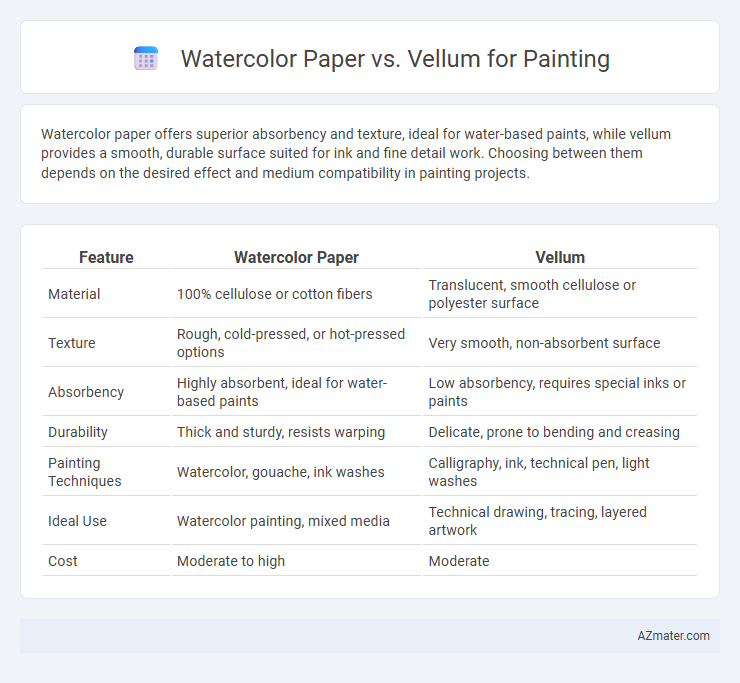Watercolor paper offers superior absorbency and texture, ideal for water-based paints, while vellum provides a smooth, durable surface suited for ink and fine detail work. Choosing between them depends on the desired effect and medium compatibility in painting projects.
Table of Comparison
| Feature | Watercolor Paper | Vellum |
|---|---|---|
| Material | 100% cellulose or cotton fibers | Translucent, smooth cellulose or polyester surface |
| Texture | Rough, cold-pressed, or hot-pressed options | Very smooth, non-absorbent surface |
| Absorbency | Highly absorbent, ideal for water-based paints | Low absorbency, requires special inks or paints |
| Durability | Thick and sturdy, resists warping | Delicate, prone to bending and creasing |
| Painting Techniques | Watercolor, gouache, ink washes | Calligraphy, ink, technical pen, light washes |
| Ideal Use | Watercolor painting, mixed media | Technical drawing, tracing, layered artwork |
| Cost | Moderate to high | Moderate |
Introduction: Watercolor Paper vs Vellum
Watercolor paper features a textured surface designed to absorb pigments and water, enhancing color vibrancy and control during painting. Vellum, a smooth and semi-translucent material, offers a unique surface that resists heavy water absorption, making it suitable for detailed line work and mixed-media techniques. Choosing between watercolor paper and vellum depends on the desired texture, absorbency, and artistic effect for your painting project.
Defining Watercolor Paper: Key Features
Watercolor paper is specifically designed to handle the unique properties of watercolor paints, featuring a textured surface that enhances pigment absorption and color vibrancy. It typically comes in various weights, with 140 lb (300 gsm) being the most popular for preventing warping and allowing multiple washes. Unlike vellum, which is smooth and translucent, watercolor paper's fibrous composition provides superior durability and the ability to hold water without buckling.
What is Vellum? Characteristics and Types
Vellum is a smooth, translucent material traditionally made from calfskin, now often produced using synthetic or plant-based fibers, prized for its durability and ability to hold ink and paint with precision. It features a smooth surface ideal for detailed work, resisting warping and aging better than traditional paper. Types of vellum include natural vellum, parchment, and synthetic vellum, each varying in texture and opacity but commonly used in fine art, calligraphy, and technical drawing.
Surface Texture: Comparing Feel and Finish
Watercolor paper features a textured surface that enhances pigment absorption and creates vibrant washes, offering a tactile, grainy feel ideal for traditional watercolor techniques. Vellum, with its smooth and translucent finish, provides a sleek surface that allows for precise brush control but limits pigment absorption, resulting in sharper, more delicate details. Choosing between these materials depends on the desired effect: textured dynamism on watercolor paper versus refined smoothness on vellum.
Absorbency and Paint Behavior Differences
Watercolor paper exhibits high absorbency, allowing it to soak up water and pigments effectively, resulting in vibrant, diffused color blends. Vellum, with its smooth, non-absorbent surface, resists water absorption, causing paint to sit on top and dry slower, which can create sharper lines and unique textures. The difference in absorbency directly influences paint behavior, as watercolor paper facilitates fluid washes while vellum demands controlled application to prevent pooling and ensure desired effects.
Durability and Archival Qualities
Watercolor paper offers superior durability and archival qualities compared to vellum, as it is specifically designed to absorb water and resist warping or deterioration over time. Vellum, made from animal skin or synthetic materials, is less stable when exposed to moisture and prone to yellowing or becoming brittle. For long-lasting artworks, watercolor paper maintains color integrity and structural strength, ensuring preservation for decades.
Effects on Color Vibrancy and Blending
Watercolor paper offers superior texture and absorbency, enhancing color vibrancy by allowing pigments to settle richly and blend smoothly, resulting in vivid and dynamic washes. Vellum's smooth, non-absorbent surface often causes pigments to sit on top, leading to less intense colors but enabling controlled, subtle blending and layering effects. Artists seeking bold saturation prefer watercolor paper, while vellum suits detailed work with delicate tonal transitions.
Suitability for Various Watercolor Techniques
Watercolor paper offers a textured surface ideal for techniques like wet-on-wet and dry brush, allowing for better pigment absorption and color blending. Vellum, being smoother and less absorbent, suits detail-oriented methods such as glazing and layering, providing a crisp finish without excessive bleeding. Artists select paper based on technique needs, with watercolor paper supporting expressive washes and vellum excelling in precision work.
Cost, Availability, and Sizing Options
Watercolor paper generally offers a more affordable and widely available option compared to vellum, making it accessible for various painting projects. It comes in multiple sizing options, including sheets, blocks, and rolls, which cater to diverse artistic needs. Vellum tends to be pricier and less common, with limited sizing choices, often preferred for specialized artwork or mixed media applications.
Choosing the Right Surface: Which is Best for You?
Watercolor paper offers a textured surface ideal for absorbing water and pigment, making it perfect for vibrant washes and layered techniques, while vellum provides a smooth, translucent surface favored for detailed ink work and precise brush strokes. Artists seeking durability and rich color depth often prefer cold-pressed or hot-pressed watercolor paper with varying textures, whereas vellum suits those prioritizing smoothness and translucency in their artwork. Understanding the specific needs of your painting style and medium helps determine whether the absorbency and texture of watercolor paper or the sleek finish of vellum aligns best with your creative goals.

Infographic: Watercolor paper vs Vellum for Painting
 azmater.com
azmater.com